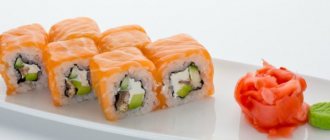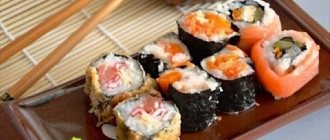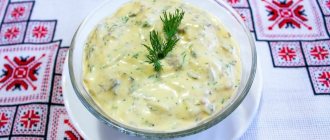How can you replace rice vinegar for sushi and rolls?
If the store doesn’t have rice vinegar, but you really want to cook something “Japanese,” you can use substitutes for this product. Analogues are prepared from table and fruit vinegar solutions and additives to them.
- Grape vinegar (8 parts) is combined with three parts granulated sugar, and a teaspoon of salt is added. Mix the ingredients and cook until the sugar dissolves. Remove the mixture from the stove before it begins to boil and cool.
- Mix apple juice with granulated sugar and salt (0.5 teaspoon each), add one and a half tablespoons of boiled hot water to the mixture. The solution is stirred until the granulated sugar is completely dissolved, then the substitute is added to the dish.
- Table vinegar and soy sauce are combined with sugar in a ratio of 2:2:0.8. Mix the ingredients with a whisk until the sugar is completely dissolved.
- Nori seaweed (2 medium sheets) is ground in a mortar to a powder. Add two teaspoons of sugar and salt (to taste) to table vinegar or any fruit vinegar (5 tablespoons). The ingredients are heated and seaweed powder is added.
- Lemon juice is mixed with water, salted and sugar is added. The quantity of components is chosen to taste.
- Balsamic, red wine, apple, Worcestershire sauce are taken in equal quantities. A pinch of sugar is added to the composition.
It is not recommended to add kelp to a vinegar substitute. This algae gives the product bitterness.
How to make sushi vinegar
We offer a Far Eastern recipe for sushi vinegar
, which was proposed by Japanese chefs who worked in Kamchatka in the early 90s.
Ingredients:
- Rice vinegar – 450 ml.
- Granulated sugar – 300 g.
- Salt – 80 g.
- Mirin sauce – 50 ml.
- Adinomoto (Japanese flavor enhancer) – 5 g.
- Seaweed leaves (kelp) – 5 g.
You should get approximately 870 ml of finished product.
Preparation:
All components of the future sauce are placed in a deep container and placed on low heat, stirring constantly and continuously to prevent the granulated sugar from burning. Heat the mixture only to dissolve the salt and sugar
. Do not bring it to a boil!
The product can be considered ready if the salt and sugar have dissolved and the liquid has become completely clear.
. At the very end of cooking, you need to add kelp leaves: during the infusion process, it will give the sauce the necessary rich taste.
The minimum time for infusing sushi sauce is at least 60 minutes. After this, it can be used for cooking.
The sauce prepared according to this recipe does not have an expiration date. You can store it at room temperature, which will save you from the mistake made by inexperienced cooks who pour cold sauce over hot rice that was in the refrigerator.
How much rice vinegar to add to sushi rice
Recipes often don't specify what type of rice vinegar the cook uses.
For example, for 250-300 grams of boiled rice, it is recommended to take 1-2 tablespoons of vinegar.
In most recipes, per 300-400 gram serving add 2 tablespoons of red rice vinegar, or 2-3 tablespoons of white.
The amount of black vinegar depends on the concentration and ranges from a few drops to 1 teaspoon for the same amount of rice.
Substitution in rolls and sushi
You can use any of the listed dressings; the choice of one or another substitute depends only on the remaining ingredients included in the dish. You won’t add green dressing with seaweed to sweet rolls, but lemon dressing will come in handy.
Over the past decade, rice vinegar has gained widespread popularity in international cuisine. Today, this type of vinegar, the most common in Asia, is increasingly used in the preparation of European dishes.
Types of Rice Vinegar
There are several types of rice dressing. They differ in composition and taste characteristics.
- White vinegar has a mild, moderately sour taste and a faint sweetish odor. The product is made from regular or glutinous round rice. Acetic liquid is a clear solution (colorless or yellowish).
- Red - represents a concentrated transparent liquid of a rich red color. The taste of the liquid is tart, sweetish, with a fruity component. The product is obtained by fermenting red yeast rice. This rice is prepared by growing the fungus Monascus of the genus purpureus on polished grains. When fermented, the fungus gives the rice grains a reddish and purple color.
- Black vinegar is made from a mixture of round glutinous rice and long brown rice. The cooking technology uses sorghum grain, bran, and legumes (most often peas). Rice husks, barley and wheat are added. Manufacturing takes from 6 to 7 months. During this time, the product undergoes double fermentation. At the exit it is a concentrated dark brown liquid with a tart, sweetish taste.
See also: Apple cider vinegar: benefits, treatment methods
You can find dozens of types of rice vinegar on sale, including in online stores. The taste and aromas of products with the same name can vary greatly. This is due to the characteristics of technology from different manufacturers.
Vinegar can be more or less tart. To do this, manufacturers add caramel additive and herbal extracts.
What should not be substituted for rice vinegar or how not to spoil sushi?
Experienced sushi chefs strongly do not recommend using balsamic vinegar as a substitute. Its recipe involves the use of herbs, which can distort the taste of rice and dishes made from it. As a result, instead of light sourness, you get a bouquet of herbs.
Also, you should not use 9% table vinegar to prepare substitutes for rice vinegar. This will add excess acidity and a strong acetic acid flavor to the dish.
Most people are skeptical about rice vinegar substitutes, believing that they spoil the taste of sushi. But sushi experts refute this point of view. Skillful preparation of rice vinegar analogues and their correct use will give your dishes a real taste of Japanese cuisine.
There is hardly a housewife who, at least once in her life, has not tried to cook something unusual for her family.
If you have not yet achieved such a feat, I invite you to join me in wondering about the method of preparing sushi dressing.
How to replace rice vinegar or how to prepare it at home - that’s what my article today will be about.
After staying with my younger sister, the strong desire to make sushi at home has been haunting me for a couple of weeks now.
For some time I looked closely at the prices of ingredients, read the advice of experienced sushi experts, and asked my sister for proprietary secrets. Ultimately, I learned how to cook sushi rice, completed the roll-wrapping course, and the desire to make sushi at home reached its highest intensity.
The main ingredients for the rapidly gaining popularity of sushi are rice, rice vinegar (impregnation for finished vinegar) and kombu seaweed (another name for nori).
The question that remains is how to make this dish cheaper, that is, how to replace expensive products. A Japanese woman uses the very best to prepare sushi, but a real Russian woman can create a hairstyle, a scandal and a salad out of nothing... And so let’s try!
Recipes for making rice vinegar at home
It is difficult to make red or black rice vinegar at home. This is due to the complexity of the technology and the long holding time. Therefore, housewives cook only white, changing the amount of ingredients.
Classic recipe
Ingredients:
- regular round rice - 2 cups (200 ml each);
- white from 2 chicken eggs;
- instant dry yeast - half a tablespoon;
- granulated sugar - 600 grams;
- water - 8 glasses.
Preparation:
- Rice is poured into a pan, washed and filled with cold water.
- Keep the pan at room temperature for 4 hours, then put it in the refrigerator (overnight). Strain the contents of the container through cheesecloth (do not squeeze out the rice).
- Sugar is poured into the rice infusion. Stir the liquid until the granulated sugar is completely dissolved, pour into another pan.
- The vessel is placed in a water bath, heated and boiled for 20 minutes.
- The wort is cooled to 38°C and poured into a large jar. Yeast is added and the liquid is stirred.
- Cover the jar with gauze and leave the wort to ferment at room temperature for 7 days. The jar should not be exposed to direct sunlight.
- After a week, the wort is poured into a new jar, leaving sediment at the bottom. Cover the vessel with gauze and leave it in the room for another month.
- After a month, the finished product is poured into another vessel using a hose. The product is boiled, and while boiling, egg white is added to the pan to reduce turbidity. The liquid will become more transparent after the procedure.
- After cooling, the product is poured into sterilized bottles with sealed stoppers.
Simple recipe
Ingredients:
- granulated sugar - 900 grams;
- long grain rice - 300 grams;
- instant yeast - a third of a tablespoon;
- drinking water - 1.2 liters.
Preparation:
- Rice is washed in running water and soaked for 4 hours. Take it to a cool place overnight or put the pan in the refrigerator.
- Add sugar and stir the solution. The mixture is boiled for 20-25 minutes in a water bath.
- Add yeast and leave the container for several days until fermentation stabilizes and the bubbles disappear (4-7 days).
- Pour the wort into another jar (it is better to use a hose so as not to drain the sediment).
- Cover the jar with a cloth and keep the vessel in the house for one to one and a half months.
- The product is poured into bottles, filled with wax or sealed caps and stored in a cool place.
What not to use
Experienced cooks are strongly against using balsamic vinegar when making rice vinegar. The latter has a bright, specific taste, infused with a bouquet of herbs. It is completely capable of changing the taste of rice, which should have just a hint of sourness.
We use 9% or 6% table vinegars, which are familiar to our kitchens, only as a last resort.
If you have already learned how to cook sushi at home and have decided that it will become a frequent guest on your menu, you should not use substitute dressings. I suggest making a dressing for rice for future use.
To prepare real rice vinegar at home, we need:
- 1 cup short grain rice
- 250 ml water
- 4 tbsp. Sahara
- Dry yeast – 1/3 teaspoon
Preparation
After the solution stops bubbling (the fermentation process is complete), let the rice-sugar solution brew for another month.
After the specified time, filter the resulting mixture again through cheesecloth and boil. Do not be alarmed if the vinegar turns out cloudy - this is its normal condition. If you wish, you can lighten the solution by adding beaten egg white to it while boiling.
The clarification process will require another filtration, after which we pour the homemade rice vinegar into a dark glass bottle and store it in the refrigerator.
Uses of rice vinegar
| Type of rice vinegar | Application |
| White | Additive to rice for sushi, rolls and sashimi Deep frying for seafood Salad seasoning Sauce for dipping meat Marinade for fish and meat Salad dressing (including sunomono from cucumbers and daikon radish) White vinegar is drunk undiluted at low acidity in stomach |
| Red | Additive to rice for sushi and rolls, sashimi Ingredient in marinades Ingredient in sauces Seasoning for salads Flavoring additive in noodles and soups Additive in seafood dishes Marinade for fish and seafood |
| Black | Flavoring additive in rice for sushi, sashimi and rolls Ingredient in marinades Flavoring additive in fish and seafood dishes Flavoring additive in marinated, stewed and fried meat |
In China, white rice vinegar is drunk undiluted when the acidity is low. In the same country, rice black vinegar is used as a means of losing weight (one tablespoon before each meal). But you should not use such recipes without consulting a doctor.
Options for marinating meat, fish, ginger
When pickling ginger, rice vinegar is traditionally used; it can be replaced with apple or grape vinegar, diluted to 4% concentration. Store-bought ones have a concentration of 9%. To obtain a solution of 4% concentration, you need to dilute them with boiled water: 1 part vinegar to 1.5 parts water.
A substitute for marinating seafood or meat is soaking it in lemon juice, pre-mixed with sugar dissolved in boiled water:
- lemon juice - 4 tbsp. spoons;
- boiled water - 4 tbsp. spoons;
- sugar - 2 teaspoons.
Before marinating, seafood is thawed and boiled for 2-3 minutes in salted water:
- prepare a marinade of lemon, sugar and water using the proportions described above;
- Place cooled seafood in a small container;
- add 1 tbsp. a spoonful of vegetable oil (for 2 tsp lemon marinade), add spices if desired;
- mix with your hand, distributing the ingredients evenly and close the container with a lid;
- leave for 10–12 hours in a cool, dark place.
When pickling ginger, rice vinegar can be replaced with grape or apple vinegar.
Video recipe - pickled ginger
Don’t give up on preparing and trying delicious and healthy dishes just because unfamiliar food names scare you. Make sushi and rolls at home without significant costs by replacing rice vinegar with apple or wine vinegar, as well as lemon juice. If you intend to achieve a taste close to the original, make your own rice vinegar.
Rice vinegar is a healthy product that is used to prepare oriental dishes. This is a mandatory ingredient for rolls and sushi, which cannot be excluded from the recipe, but can be replaced.
Chemical composition of rice vinegar
The main component of vinegar is acetic acid (CH3COOH). This substance gives the product its pungency.
See also: How to remove bitterness from mushrooms
Rice vinegar contains vitamins D, E, H, PP, C, and trace elements:
- sodium;
- zinc;
- calcium;
- manganese;
- potassium;
- phosphorus;
- magnesium.
The calorie content of the product is 54 kcal per 100 grams of liquid. The same amount of rice vinegar contains:
- protein - 0.3 grams;
- carbohydrates - 13.8 grams.
How is it different from other types of vinegar?
Firstly, it is not so “caustic” and does not harm the gastric mucosa; there are no contraindications for its use in diseases of the gastrointestinal tract.
Secondly, the most important property of rice vinegar is its ability to reduce the calorie content of foods to which it is added, as well as promote proper metabolism.
And thirdly, rice vinegar contains the largest number of amino acids, 20 of them! They fight against waste and toxins in the body.
Rice vinegar is a dietary product
Benefits and harms
Rice vinegar has a complex composition and has a beneficial effect on the body, therefore it is considered a valuable food product. In China, this seasoning is considered a medicine.
✅️ Useful properties:
- The product contains substances that break down heavy foods.
- Normalize metabolic processes and energy production.
- Contains potassium in an easily digestible form.
- Helps restore bone tissue and heal joints.
- Regulates water-salt and alkaline balance.
- Supplies phosphorus to the body, which is important for the musculoskeletal system and body tissues.
- It does not irritate the stomach; rice vinegar can be included in the diet for gastritis and stomach ulcers.
- Contains more than 20 amino acids, which helps eliminate toxins. Amino acids block chemical processes involving free radicals and prevent their formation.
- By accelerating metabolic processes, it promotes tissue restoration and rejuvenation of the body.
- Removes “bad” cholesterol and maintains healthy blood vessels.
- Inhibits putrefactive decomposition of protein fibers in the intestines.
- Stimulates the secretion of gastric juice.
- Stimulates intestinal motility and relieves constipation.
- Destroys fungal and bacterial flora in the intestines.
- Reduces discomfort and pain during menopause.
- Rice vinegar can be included in the menu of health-improving diets.
Harm of rice vinegar:
- The product should not be used if you have an allergic reaction in the form of rash, swelling, nausea, burning in the stomach and other symptoms of intolerance.
- If you have diabetes, it is recommended to exclude rice vinegar from the menu, as it contains sugar.
- Acid can aggravate hypertension and kidney disease.
The effect of rice vinegar on the body of pregnant women and children has not been studied. You should consult your doctor before including this product in your diet.
Options for marinating meat, fish, ginger
When pickling ginger, rice vinegar is traditionally used; it can be replaced with apple or grape vinegar, diluted to 4% concentration. Store-bought ones have a concentration of 9%. To obtain a solution of 4% concentration, you need to dilute them with boiled water: 1 part vinegar to 1.5 parts water.
A substitute for marinating seafood or meat is soaking it in lemon juice, pre-mixed with sugar dissolved in boiled water:
- lemon juice - 4 tbsp. spoons;
- boiled water - 4 tbsp. spoons;
- sugar - 2 teaspoons.
Before marinating, seafood is thawed and boiled for 2-3 minutes in salted water:
- prepare a marinade of lemon, sugar and water using the proportions described above;
- Place cooled seafood in a small container;
- add 1 tbsp. a spoonful of vegetable oil (for 2 tsp lemon marinade), add spices if desired;
- mix with your hand, distributing the ingredients evenly and close the container with a lid;
- leave for 10–12 hours in a cool, dark place.
When pickling ginger, rice vinegar can be replaced with grape or apple vinegar.
Video recipe - pickled ginger
Don’t give up on preparing and trying delicious and healthy dishes just because unfamiliar food names scare you. Make sushi and rolls at home without significant costs by replacing rice vinegar with apple or wine vinegar, as well as lemon juice. If you intend to achieve a taste close to the original, make your own rice vinegar.
The question of what to replace rice vinegar worries many lovers of Japanese cuisine. You probably already know that getting this product can be quite difficult - unlike soy sauce, it is not freely available in all stores. We will tell you how to find a suitable analogue and make it yourself at home.











